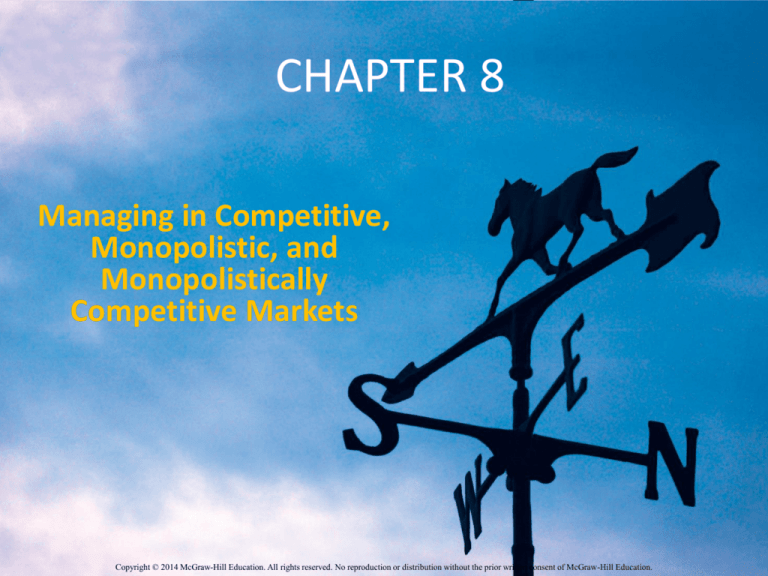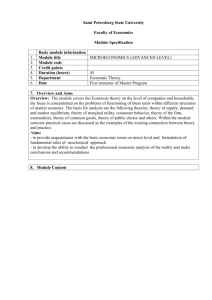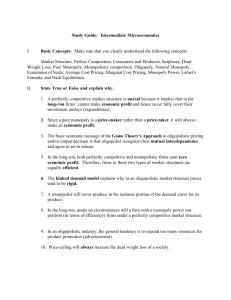
CHAPTER 8
Managing in Competitive,
Monopolistic, and
Monopolistically
Competitive Markets
Copyright © 2014 McGraw-Hill Education. All rights reserved. No reproduction or distribution without the prior written consent of McGraw-Hill Education.
Chapter Outline
Chapter Overview
• Perfect competition
– Demand at the market and firm levels
– Short-run output decisions
– Long-run decisions
• Monopoly
–
–
–
–
Monopoly power
Sources of monopoly power
Maximizing profits
Implications of entry barriers
• Monopolistic competition
–
–
–
–
Conditions for monopolistic competition
Profit maximization
Long-run equilibrium
Implications of product differentiation
• Optimal advertising decisions
8-2
Key Conditions
Perfect Competition
• Perfectly competitive markets are characterized
by:
– The interaction between many buyers and sellers that
are “small” relative to the market.
– Each firm in the market produces a homogeneous
(identical) product.
– Buyers and sellers have perfect information.
– No transaction costs.
– Free entry into and exit from the market.
• The implications of these conditions are:
– a single market price is determined by the interaction
of demand and supply
– firms earn zero economic profits in the long run.
8-3
Perfect Competition
Demand at the Market and Firm Levels In Action
Price
Price
Market
Firm
S
𝑃𝑒
𝐷 𝑓 = 𝑃𝑒
D
0
Market
output
Firm’s
output
8-4
Perfect Competition
Short-Run Output Decisions
• The short run is a period of time over which
some factors of production are fixed.
• To maximize short-run profits, managers must
take as given the fixed inputs (and fixed costs),
and determine how much output to produce
by changing the variable inputs.
8-5
Perfect Competition
Short-Run Profit Maximization:
Revenue-Cost Approach In Action
Costs
𝐶 𝑄
$
Revenue
𝑅 =𝑃×𝑄
B
Maximum
profits
Slope of 𝐶 𝑄 = 𝑀𝐶
Slope of 𝑅 = 𝑀𝑅 = 𝑃
A
0
E
𝑄∗
Firm’s output
8-6
Perfect Competition
Competitive Firm’s Demand
• The demand curve for a competitive firm’s
product is a horizontal line at the market
price. This price is the competitive firm’s
marginal revenue.
𝐷 𝑓 = 𝑃 = 𝑀𝑅
8-7
Perfect Competition
Short-Run Profit Maximization In Action
$
𝑀𝐶
𝑃𝑒
𝐴𝑇𝐶
𝐴𝑇𝐶
𝐷 𝑓 = 𝑃𝑒 = 𝑀𝑅
Profit
𝑄∗
0
𝑄∗
Firm’s output
8-8
Perfect Competition
Competitive Output Rule
• To maximize profits, a perfectly competitive
firm produces the output at which price
equals marginal cost in the range over which
marginal cost is increasing.
𝑃 = 𝑀𝐶 𝑄
8-9
Perfect Competition
Competitive Output Rule In Action
• The cost function for a firm is 𝐶 𝑄 = 5 + 𝑄 2 .
If the firm sells output in a perfectly
competitive market and other firms in the
industry sell output at a price of $20, what
price should the manager of this firm charge?
What level of output should be produced to
maximize profits? How much profit will be
earned?
• MC=2Q
8-10
Perfect Competition
Short-Run Loss Minimization In Action
$
𝐴𝑇𝐶
𝑀𝐶
𝐴𝑇𝐶 𝑄 ∗
Loss
𝑃𝑒
0
𝐴𝑉𝐶
𝐷 𝑓 = 𝑃𝑒 = 𝑀𝑅
𝑄∗
Firm’s output
8-11
Perfect Competition
The Shut-Down Case In Action
𝑀𝐶
$
𝐴𝑇𝐶
𝐴𝑉𝐶
Loss if shut down
𝐴𝑇𝐶 𝑄 ∗
Fixed Cost
𝐴𝑉𝐶 𝑄 ∗
𝑃𝑒
𝐷 𝑓 = 𝑃𝑒 = 𝑀𝑅
Loss if produce
0
𝑄∗
Firm’s output
8-12
Perfect Competition
Short-Run Output Decision
• To maximize short-run profits, a perfectly
competitive firm should produce in the range
of increasing marginal cost where 𝑃 = 𝑀𝐶,
provided that 𝑃 ≥ 𝐴𝑉𝐶. If 𝑃 < 𝐴𝑉𝐶, the firm
should shut down its plant to minimize it
losses.
8-13
Perfect Competition
Short-Run Firm Supply Curve In Action
𝑀𝐶
$
Short-run supply
curve for individual firm
𝐴𝑉𝐶
𝑃1
𝑃0
0
𝑄0
𝑄1 Firm’s output
8-14
Perfect Competition
Firm’s Short-Run Supply Curve
• The short-run supply curve for a perfectly
competitive firm is its marginal cost curve
above the minimum point on the 𝐴𝑉𝐶 curve.
8-15
Perfect Competition
Market Supply Curve In Action
P
Individual firm’s
supply curve
𝑀𝐶𝑖
Market supply
curve
S
$12
$10
0
1
500
Market output
8-16
Perfect Competition
Long-Run Decisions: Entry and Exit In Action
𝑆2
Price
Price
𝑆0
𝐸𝑥𝑖𝑡
𝐸𝑛𝑡𝑟𝑦
𝑆1
𝑃2
𝐷 𝑓 = 𝑃2 = 𝑀𝑅2
Exit
𝑃0
Entry
𝑃1
𝐷 𝑓 = 𝑃0 = 𝑀𝑅0
𝐷 𝑓 = 𝑃1 = 𝑀𝑅1
D
0
Market
output
0
Firm’s
output
8-17
Perfect Competition
Long-Run Competitive Equilibrium In Action
𝑀𝐶
$
Long-run competitive
equilibrium
𝐴𝐶
𝐷 𝑓 = 𝑃𝑒 = 𝑀𝑅
𝑃𝑒
0
𝑄∗
Firm’s output
8-18
Perfect Competition
Long-Run Competitive Equilibrium
• In the long run, perfectly competitive firms
produce a level of output such that
𝑃 = 𝑀𝐶
𝑃 = 𝑚𝑖𝑛𝑖𝑚𝑢𝑚 𝑜𝑓 𝐴𝐶
8-19
Monopoly
Monopoly and Monopoly Power
• A market structure in which a single firm serves
an entire market for a good that has no close
substitutes.
• Sole seller of a good in a market gives that firm
greater market power than if it competed
against other firms.
– Implication:
• market demand curve is the monopolist’s demand curve.
– However, a monopolist does not have unlimited
market power.
8-20
Monopoly
Monopolist’s Demand In Action
Monopolist’s power is constrained
by the demand curve.
Price
A
𝑃0
B
𝑃1
𝐷 𝑓 = 𝐷𝑀
0
𝑄0
𝑄1
Output
8-21
Sources of Monopoly Power
•
•
•
•
Monopoly
Economies of scale
Economies of scope
Cost complementarity
Patents and other legal barriers
8-22
Copyright © 2014 by the McGraw-Hill Companies, Inc. All rights
reserved.
2-23
Elasticity of Demand and
Total Revenues In Action
Price
Monopoly
Revenue
Maximum revenues
𝑃0 × 𝑄0
Elastic
Unitary
𝑅0
Unitary
𝑃0
Total Revenue
Curve
Inelastic
Elastic
Inelastic
D
0
𝑄0
Q
MR
0
𝑄0
Firm’s
output
8-24
Monopoly
Marginal Revenue and Elasticity
• The monopolist’s marginal revenue function is
1+𝐸
𝑀𝑅 = 𝑃
𝐸
, where 𝐸 is the elasticity of demand for the
monopolist’s product and 𝑃 is the price charged.
– For 𝑃 > 0
• 𝑀𝑅 > 0 when 𝐸 < −1.
• 𝑀𝑅 = 0 when 𝐸 = −1.
• 𝑀𝑅 < 0 when −1 < 𝐸 < 0.
8-25
Monopoly
Marginal Revenue and Linear Demand
• Given an linear inverse demand function
𝑃 𝑄 = 𝑎 + 𝑏𝑄
, where 𝑎 > 0 𝑎𝑛𝑑 𝑏 < 0, the associated
marginal revenue is
𝑀𝑅 𝑄 = 𝑎 + 2𝑏𝑄
8-26
Marginal Revenue In Action
Monopoly
• Suppose the inverse demand function for a
monopolist’s product is given by 𝑃 = 10 −
2𝑄. What is the maximum price per unit a
monopolist can charge to be able to sell 3
units? What is marginal revenue when 𝑄 = 3?
• Answer:
– The maximum price the monopolist can charge for
3 units is: 𝑃 = 10 − 2 3 = $4.
– The marginal revenue at 3 units for this inverse
linear demand is: 𝑀𝑅 = 10 − 2 2 3 = −$2.
8-27
Output Rule
Monopoly
• A profit-maximizing monopolist should
produce the output, 𝑄 𝑀 , such that marginal
revenue equals marginal cost:
𝑀𝑅 𝑄 𝑀 = 𝑀𝐶 𝑄𝑀
8-28
Monopoly
Costs, Revenues, and Profit In Action
𝐶 𝑄
Cost function
$
𝑅 =𝑃 𝑄 ×𝑄
Revenue function
Slope of
𝑅 = 𝑀𝑅
0
Maximum
profit
𝑄𝑀
Slope of
𝐶 𝑄 = 𝑀𝐶
Output
8-29
Profit Maximization In Action
Price
𝑃𝑟𝑜𝑓𝑖𝑡𝑠 =
𝑃𝑀 − 𝐴𝑇𝐶 𝑄𝑀 × 𝑄𝑀
Monopoly
MC
ATC
𝑃𝑀
Profits
𝐴𝑇𝐶(𝑄𝑀 )
Demand
𝑄𝑀
MR
Quantity
8-30
Pricing Rule
Monopoly
• Given the level of output, 𝑄 𝑀 , that maximizes
profits, the monopoly price is the price on the
demand curve corresponding to the 𝑄 𝑀 units
produced:
𝑃𝑀 = 𝑃 𝑄𝑀
8-31
Monopoly In Action
Monopoly
• Suppose the inverse demand function for a
monopolist’s product is given by 𝑃 = 100 −
2𝑄 and the cost function is 𝐶 𝑄 = 10 + 2𝑄.
Determine the profit-maximizing price,
quantity and maximum profits.
• Answer:
– MR=100-4Q
– MC=2
8-32
Monopoly
Absence of a Supply Curve
• Recall, firms operating in perfectly competitive
markets determine how much output to
produce based on price (𝑃 = 𝑀𝐶).
– Thus, a supply curve exists in perfectly
competitive markets.
• A monopolist’s market power implies 𝑃 >
𝑀𝑅 = 𝑀𝐶.
– Thus, there is no supply curve for a monopolist, or
in markets served by firms with market power.
8-33
Multiplant Decisions
Monopoly
• Often a monopolist produces output in different
locations.
– Implications: manager has to determine how much
output to produce at each plant.
• Consider a monopolist producing output at two
plants:
– The cost of producing 𝑄1 units at plant 1 is 𝐶 𝑄1 , and
the cost of producing 𝑄2 at plant 2 is 𝐶 𝑄2 .
– When the monopolist produces a homogeneous
product, the per-unit price consumers are willing to
pay for the total output produced at the two plants is
𝑃 𝑄 , where 𝑄 = 𝑄1 + 𝑄2 .
8-34
Multiplant Output Rule
Monopoly
• Let 𝑀𝑅 𝑄 be the marginal revenue of
producing a total of 𝑄 = 𝑄1 + 𝑄2 units of
output.
• Suppose the marginal cost of producing 𝑄1
units of output in plant 1 is 𝑀𝐶1 𝑄1 and that
of producing 𝑄2 units in plant 2 is 𝑀𝐶2 𝑄2 .
• The profit-maximizing rule for the two-plant
monopolist is to allocate output among the
two plants such that:
𝑀𝑅 𝑄 = 𝑀𝐶1 𝑄1
𝑀𝑅 𝑄 = 𝑀𝐶2 𝑄2
8-35
Implications of Entry Barriers
Monopoly
• A monopolist may earn positive economic
profits, which in the presence of barriers to
entry prevents other firms from entering the
market to reap a portion of those profits.
– Implication: monopoly profits will continue over
time provided the monopoly maintains its market
power.
• Monopoly power, however, does not
guarantee positive profits.
8-36
Monopoly
Zero-Profit Monopolist In Action
Price
MC
ATC
𝑃𝑀 = 𝐴𝑇𝐶(𝑄 𝑀 )
Demand
𝑄𝑀
MR
Quantity
8-37
Deadweight Loss of Monopoly
Monopoly
• The consumer and producer surplus that is
lost due to the monopolist charging a price in
excess of marginal cost.
8-38
Monopoly
Deadweight Loss of Monopolist In Action
Price
𝑃
MC
𝑀
Deadweight loss
𝑃𝐶
Demand
MR
𝑄𝑀
𝑄𝐶
Quantity
8-39
Monopolistic Competition
Monopolistic Competition: Key Conditions
• An industry is monopolistically competitive if:
– There are many buyers and sellers.
– Each firm in the industry produces a differentiated
product.
– There is free entry into and exit from the industry.
• A key difference between monopolistically
competitive and perfectly competitive markets is
that each firm produces a slightly differentiated
product.
– Implication: products are close, but not perfect,
substitutes; therefore, firm’s demand curve is
downward sloping under monopolistic competition.
8-40
Monopolistic Competition
Profit-Maximizing Monopolistically
Competitive Firm In Action
Price
𝑃𝑟𝑜𝑓𝑖𝑡𝑠 =
𝑃∗ − 𝐴𝑇𝐶 𝑄 ∗ × 𝑄∗
MC
ATC
𝑃∗
Profits
𝐴𝑇𝐶(𝑄∗ )
Demand
𝑄∗
MR
Quantity
8-41
Monopolistic Competition
Profit-Maximization Rule
• To maximize profits, a monopolistically
competitive firm produces where its marginal
revenue equals marginal cost.
• The profit-maximizing price is the maximum
price per unit that consumers are willing to
pay for the profit-maximizing level of output.
• The profit-maximizing output, 𝑄 ∗ , is such that
𝑀𝑅 𝑄∗ = 𝑀𝐶 𝑄 ∗ and the profit-maximizing
price is 𝑃∗ = 𝑃 𝑄 ∗ .
8-42
Monopolistic Competition
Long-Run Equilibrium
• If firms in monopolistically competitive
markets earn short-run
– profits, additional firms will enter in the long run
to capture some of those profits.
– losses, some firms will exit the industry in the long
run.
8-43
Monopolistic Competition
Entry in Monopolistically
Competitive Market In Action
Price
MC
ATC
Due to entry of new
firms selling other brands
𝑃∗
Demand1
𝑄∗
MR1
MR0
Demand0
Quantity of Brand X
8-44
Monopolistic Competition
Long-Run Monopolistically
Competitive Equilibrium In Action
Price
MC
Long-run monopolistically
competitive equilibrium
ATC
𝑃∗
Demand1
𝑄∗
MR1
Quantity of Brand X
8-45
Monopolistic Competition
Long-Run and Monopolistic Competition
• In the long run, monopolistically competitive
firms produce a level of output such that:
– 𝑃 > 𝑀𝐶
– 𝑃 = 𝐴𝑇𝐶 > 𝑚𝑖𝑛𝑖𝑚𝑢𝑚 𝑜𝑓 𝑎𝑣𝑒𝑟𝑎𝑔𝑒 𝑐𝑜𝑠𝑡𝑠
8-46
Monopolistic Competition
Implications of Product Differentiation
• The differentiated nature of products in
monopolistically competitive markets implies
that firms in these industries must continually
convince consumers that their products are
better than their competitors.
• Two strategies monopolistically competitive
firms use to persuade consumers:
– Comparative advertising
– Niche marketing
8-47
Conclusion
• Firms operating in a perfectly competitive market
take the market price as given.
– Produce output where 𝑃 = 𝑀𝐶.
– Firms may earn profits or losses in the short run.
– … but, in the long run, entry or exit forces economic profits to zero.
• A monopoly firm, in contrast, can earn persistent
profits provided that the source of monopoly power
is not eliminated.
• A monopolistically competitive firm can earn profits
in the short run, but entry by competing brands will
erode these profits in the long run.
8-48







